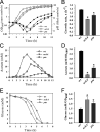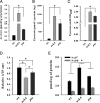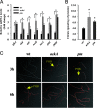Inactivation of the Pta-AckA pathway impairs fitness of Bacillus anthracis during overflow metabolism
- PMID: 33593944
- PMCID: PMC8092162
- DOI: 10.1128/JB.00660-20
Inactivation of the Pta-AckA pathway impairs fitness of Bacillus anthracis during overflow metabolism
Abstract
Under conditions of glucose excess, aerobically growing bacteria predominantly direct carbon flux towards acetate fermentation, a phenomenon known as overflow metabolism or the bacterial 'Crabtree effect'. Numerous studies of the major acetate-generating pathway, the Pta-AckA, revealed its important role in bacterial fitness through the control of central metabolism to sustain balanced growth and cellular homeostasis. In this work, we highlight the contribution of the Pta-AckA pathway to fitness of the spore-forming bacterium, Bacillus anthracis We demonstrate that disruption of the Pta-AckA pathway causes a drastic growth reduction in the mutants and alters the metabolic and energy status of the cells. Our results revealed that inactivation of the Pta-AckA pathway increases the glucose consumption rate, affects intracellular ATP, NAD+ and NADH levels and leads to a metabolic block at the pyruvate and acetyl-CoA nodes. Consequently, accumulation of intracellular acetyl-CoA and pyruvate forces bacteria to direct carbon into the TCA and/or glyoxylate cycles as well as fatty acid and poly(3-hydroxybutyrate) (PHB) biosynthesis pathways. Notably, the presence of phosphate butyryltransferase in B. anthracis partially compensates for the loss of phosphotransacetylase activity. Furthermore, overexpression of the ptb gene not only eliminates the negative impact of the pta mutation on B. anthracis fitness, but also restores normal growth in the pta mutant of the non-butyrate-producing bacterium, Staphylococcus aureus Taken together, the results of this study demonstrate the importance of the Pta-AckA pathway for B. anthracis fitness by revealing its critical contribution to the maintenance of metabolic homeostasis during aerobic growth under conditions of carbon overflow.IMPORTANCE B. anthracis, the etiologic agent of anthrax, is a highly pathogenic, spore-forming bacterium that causes acute, life-threatening disease in both humans and livestock. A greater understanding of the metabolic determinants governing fitness of B. anthracis is essential for the development of successful therapeutic and vaccination strategies aimed at lessening the potential impact of this important biodefense pathogen. This study is the first to demonstrate the vital role of the Pta-AckA pathway in preserving energy and metabolic homeostasis in B. anthracis under conditions of carbon overflow, therefore, highlighting this pathway as a potential therapeutic target for drug discovery. Overall, the results of this study provide important insight into understanding the metabolic processes and requirements driving rapid B. anthracis proliferation during vegetative growth.
Copyright © 2021 American Society for Microbiology.
Figures




Similar articles
-
Inactivation of the Pta-AckA pathway causes cell death in Staphylococcus aureus.J Bacteriol. 2013 Jul;195(13):3035-44. doi: 10.1128/JB.00042-13. Epub 2013 Apr 26. J Bacteriol. 2013. PMID: 23625849 Free PMC article.
-
Redox Imbalance Underlies the Fitness Defect Associated with Inactivation of the Pta-AckA Pathway in Staphylococcus aureus.J Proteome Res. 2016 Apr 1;15(4):1205-12. doi: 10.1021/acs.jproteome.5b01089. Epub 2016 Mar 24. J Proteome Res. 2016. PMID: 26975873 Free PMC article.
-
The Impact of ackA, pta, and ackA-pta Mutations on Growth, Gene Expression and Protein Acetylation in Escherichia coli K-12.Front Microbiol. 2020 Feb 21;11:233. doi: 10.3389/fmicb.2020.00233. eCollection 2020. Front Microbiol. 2020. PMID: 32153530 Free PMC article.
-
Effect of inactivation of nuo and ackA-pta on redistribution of metabolic fluxes in Escherichia coli.Biotechnol Bioeng. 1999 Nov 5;65(3):291-7. Biotechnol Bioeng. 1999. PMID: 10486127
-
The structure and function of novel proteins of Bacillus anthracis and other spore-forming bacteria: development of novel prophylactic and therapeutic agents.Crit Rev Biochem Mol Biol. 2002;37(5):339-73. doi: 10.1080/10409230290771537. Crit Rev Biochem Mol Biol. 2002. PMID: 12449428 Review.
Cited by
-
The crosstalk between microbiota and metabolites in AP mice: an analysis based on metagenomics and untargeted metabolomics.Front Cell Infect Microbiol. 2023 Aug 9;13:1134321. doi: 10.3389/fcimb.2023.1134321. eCollection 2023. Front Cell Infect Microbiol. 2023. PMID: 37621874 Free PMC article.
-
Unveiling the role of the PhoP master regulator in arsenite resistance through ackA downregulation in Lacticaseibacillus paracasei.Curr Res Microb Sci. 2025 Feb 5;8:100357. doi: 10.1016/j.crmicr.2025.100357. eCollection 2025. Curr Res Microb Sci. 2025. PMID: 40027449 Free PMC article.
-
Short-Chain Fatty Acid and FFAR2 Activation - A New Option for Treating Infections?Front Cell Infect Microbiol. 2021 Dec 2;11:785833. doi: 10.3389/fcimb.2021.785833. eCollection 2021. Front Cell Infect Microbiol. 2021. PMID: 34926327 Free PMC article. Review.
-
Enhancing aerobic composting of food waste by adding hydrolytically active microorganisms.Front Microbiol. 2024 Dec 2;15:1487165. doi: 10.3389/fmicb.2024.1487165. eCollection 2024. Front Microbiol. 2024. PMID: 39687869 Free PMC article.
References
Grants and funding
LinkOut - more resources
Full Text Sources
Other Literature Sources
Molecular Biology Databases

